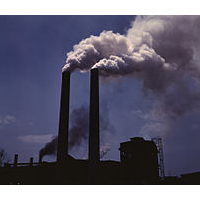Federal Court Rejects Industry Effort to Reverse EPA’s Tighter Limits on Soot

The manufacturers’ lobby has lost its bid to have new federal limits on particulate air pollution thrown out.
A three-judge panel of the U.S. Court of Appeals for the District of Columbia Circuit found the U.S. Environmental Protection Agency (EPA) was legally allowed to establish lower limits on soot.
The ruling (pdf) came in response to a lawsuit filed by the National Association of Manufacturers, which argued the EPA had overstepped its regulatory bounds in reducing annual ceilings on fine particle pollution from 15 micrograms per cubic meter to 12 micrograms per cubic meter. The EPA rules, established in 2012, also ordered dozens of major cities to monitor soot levels near congested roadways.
Federal officials said it was important to reduce soot in the air due to its harmful effects on human health, particularly the heart and the lungs.
Following the ruling, the EPA issued a statement saying it was “a resounding victory for public health and a key component of EPA and State efforts to ensure all Americans have clean air to breathe.”
Richard Lazarus, an environmental law professor at Harvard Law School, told the Los Angeles Times that the new standard was “one of EPA’s most important, because so many major stationary sources as well as motor vehicles are subject to it, particularly power plants. The regulation at issue amounts to a significant tightening of the standard, with major public health and public welfare implications.”
It’s the third major ruling in a month affirming the EPA’s ability to regulate air quality. Two weeks ago, the D.C. Circuit upheld limits on emissions of mercury and other toxic substances into the air. And last week, the Supreme Court upheld a regulation requiring states with coal-fired power plants to cut pollution that is blown across states in the Midwest and East Coast.
Industry faces costs ranging from $53 million to $350 million from having to meet the new soot standards, according to the EPA.
However, the agency says the benefits from having less soot in the air will outweigh these costs. Officials estimate the rules will provide $4 billion to $9.1 billion a year in health benefits by cutting down on particulate-related medical problems.
-Noel Brinkerhoff
To Learn More:
Obama Administration Limits on Soot Pollution Upheld by Appeals Court (by Tony Barboza, Los Angeles Times)
Court Backs EPA Move for Stricter Soot Limits (by Erica Martinson, Politico)
Overview of EPA’s Revisions to the Air Quality Standards for Particle Pollution (Particulate Matter) (Environmental Protection Agency) (pdf)
Ruling: National Association of Manufacturers v. Environmental Protection Agency and Gina McCarthy, Administrator, EPA (United States Court of Appeals) (pdf)
Soot Has Much Bigger Impact on Global Warming than Previously Thought (by Noel Brinkerhoff, AllGov)
Bipartisan Support for Combating Soot (by Jenny Kim, AllGov)
- Top Stories
- Unusual News
- Where is the Money Going?
- Controversies
- U.S. and the World
- Appointments and Resignations
- Latest News
- Trump to Stop Deportations If…
- Trump Denounces World Series
- What If China Invaded the United States?
- Donald Trump Has a Mental Health Problem and It Has a Name
- Trump Goes on Renaming Frenzy






Comments